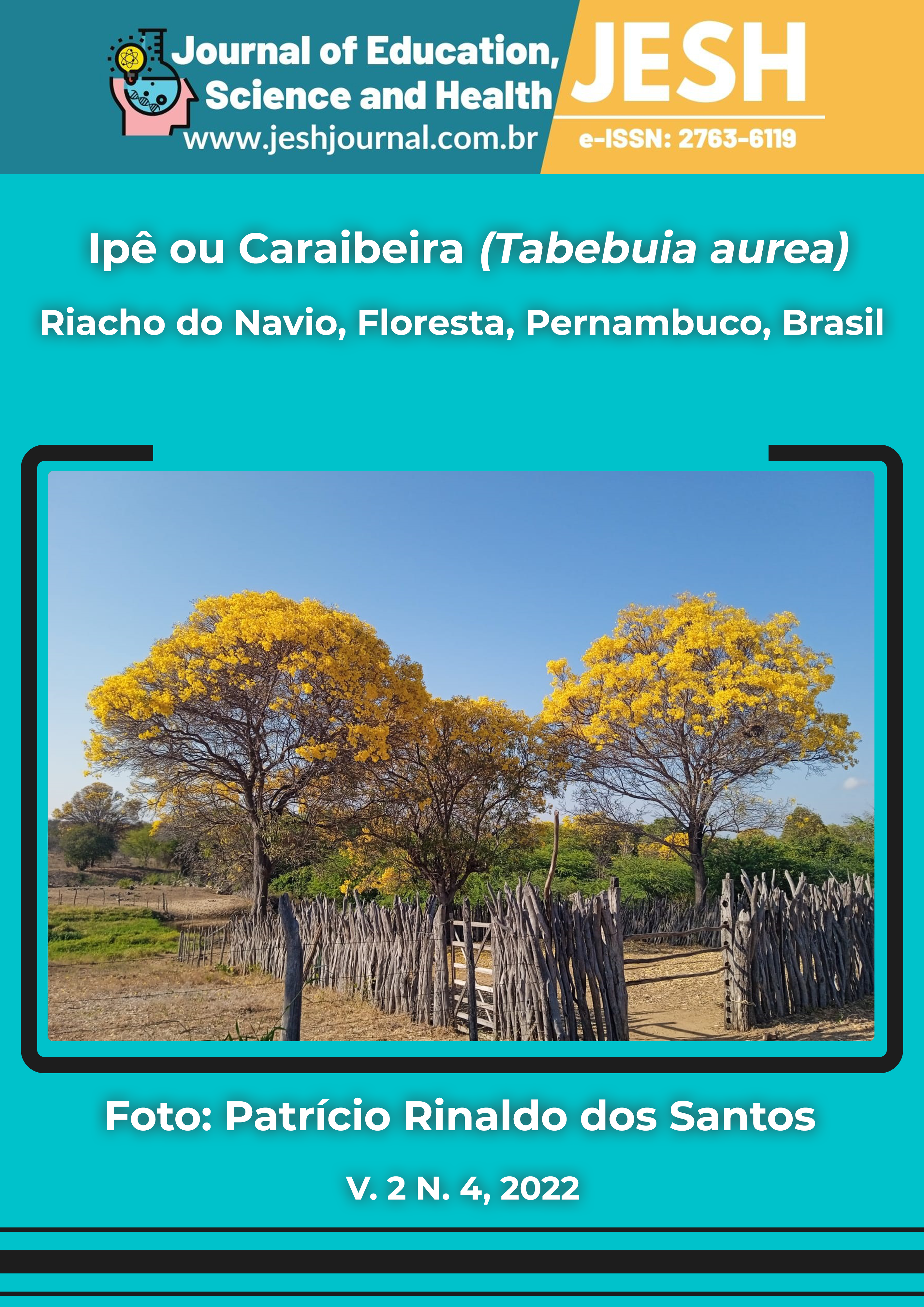USE OF MULTIPLE SAMPLE METHODS IN THE SURVEY OF SOLITARY BEES IN A SEMIARID REGION
DOI:
10.52832/jesh.v2i3.146Keywords:
Solitary bees. Sampling methods. Nest trap. Entomological net. CaatingaAbstract
The Contendas do Sincorá National Forest, in Bahia, protects an important part of the phytophysiognomic diversity of the Caatinga vegetation. Climatic seasonality is a striking feature of this biome and exerts a direct influence on bee activity. This work aims to survey the fauna of solitary bees that nest in cavities in three different landscape areas of the Caatinga biome in the Contendas do Sincorá National Forest, Bahia, using two different methodologies. A multiple sampling methodology was used using trap-nests and entomological nets. 52 individuals were sampled, distributed in 9 species, 3 genera. The genus Centris was the most abundant, with 63% of the total number of bees sampled. It was not possible to safely infer the occurrence of seasonal patterns of nesting of bee species in the study area. However, data related to species composition in times of intensified drought can be used to identify potential pollinators of agricultural crops in the semiarid region.
Downloads
Metrics
References
Aguiar, C.M., Martins, C.F., Moura, A. (1995). Recurso Florais Utilizados por Abelhas (Hymenoptera, Apoidea) em Área de Caatinga (São João Do Cariri, Paraíba). Revista Nordestina de Biologia, 10.1: 101-117.
Aguiar, C. M., & Zanella, F. C. (2005). Estrutura da comunidade de abelhas (Hymenoptera: Apoidea: Apiformis) de uma área na margem do domínio da caatinga (Itatim, BA). Neotropical Entomology, 34, 15-24. DOI: https://doi.org/10.1590/S1519-566X2005000100003
Brasil. (2006) Plano de Manejo da Floresta Nacional Contendas do Sincorá. Informações Gerais sobre a Floresta. Brasília: MMA; IBAMA. ICMBio.
Fontes, L. S., Almeida Filho, A. J. D., & Arthur, V. (2006). Estudo ecológico de abelhas silvestres (Hymenoptera, Apidae) no parque ambiental de Teresina-PI, com enfase em polinizadores potenciais de guabiraba ("Eugenia" sp) (Myrtaceae). Boletín de sanidad vegetal. Plagas, 32(2), 267-272.
Frankie, G. W., Vinson, S. B., Newstrom, l. E., & Barthell, J. F. (1988). Nest site and habitat preferences of Centris bees in the Costa Rican dry forest. Biotropica, 301-310. DOI: https://doi.org/10.2307/2388320
Garófalo, C. A. (2000) Comunidade de abelhas (Hymenoptera, Apoidea) que utilizam ninhos-armadilha em fragmentos de matas do Estado de São Paulo. Anais do Encontro sobre Abelhas, Ribeirão Preto. 4: 121-128
Institudo Brasieliro do Meio Ambiente. (2006). Plano de Manejo Floresta Nacional Contendas do Sincorá.
Krombein, K. V. (1967) Trap-nesting wasps and bees: life histories, nests, and associates. Smithsonian Institutional Press, Washington D.C. DOI: https://doi.org/10.5962/bhl.title.46295
Krug, C., Alves-dos-Santos, I.; Cane, J. (2010) Visiting bees of Cucurbita flowers (Cucurbitaceae) with emphasis on the presence of Peponapis fervens Smith (Eucerini-Apidae)–Santa Catarina, Southern Brazil. Oecologia Australis, 14 (1): 128. DOI: https://doi.org/10.4257/oeco.2010.1401.06
Laurser, L. (2015). Lone rangers: Solitary bees are vital pollinators of crops and wild habitats. Nature, vol 521. DOI: https://doi.org/10.1038/521S62a
Martins, C. F. (2002). Diversity of the bee fauna of the Brazilian Caatinga. In: Proceedings of the Workshop on the Conservation and Sustainable Use of Pollinators in Agriculture, with Emphasis on Bees, Brasília, DF. Ministry of Environment (pp. 131-134)
Schlindwein, C. (2000). A importância de abelhas especializadas na polinização de plantas nativas e conservação do meio ambiente. p. 131-141. In Anais IV Encontro Abelhas, Ribeirão Preto, USP
Viana, B. F., Silva, F. O., & Kleinert, A. M. (2001). Diversidade e sazonalidade de abelhas solitárias (Hymenoptera: Apoidea) em dunas litorâneas no nordeste do Brasil. Neotropical Entomology, 30(2): 245-251 DOI: https://doi.org/10.1590/S1519-566X2001000200006
Vieira, l., & Silva, F. A. B. (2012) Dung beetles (Coleoptera: Scarabaeidae: Scarabaeinae) of the Floresta Nacional Contendas do Sincorá, Bahia, Brazil. Check List, 8(4): 733-739 DOI: https://doi.org/10.15560/8.4.733
Zanella, F. C. V., & Martins, C. F. (2003). Abelhas da Caatinga: biogeografia, ecologia e conservação. Ecologia e conservação da Caatinga, 75-134.
Zanella, L., Borges, A. G., dos Reis, S. L., & de Andrades, H. D. S. (2022). BioIF: criação de uma coleção didática de invertebrados do IFRS Campus Osório. MoExP-Mostra de Ensino, Extensão e Pesquisa do Campus Osório, 1(1), 1-1.
Downloads
Published
How to Cite
Issue
Section
License
Copyright (c) 2022 Journal of Education, Science and Health – JESH

This work is licensed under a Creative Commons Attribution-NonCommercial 4.0 International License.

































